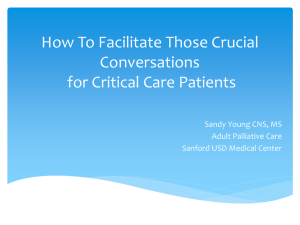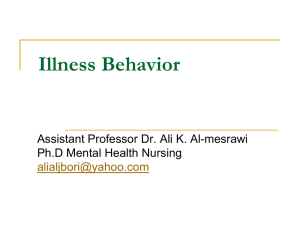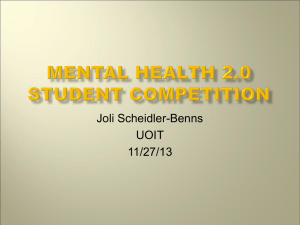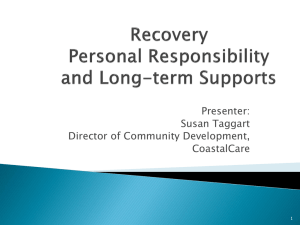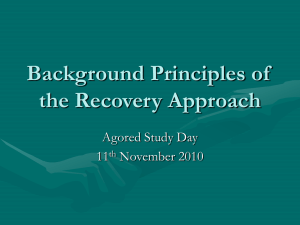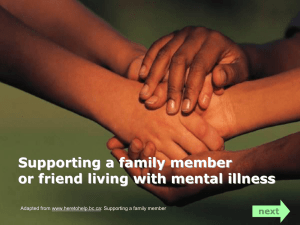Bruce Rumbold
advertisement
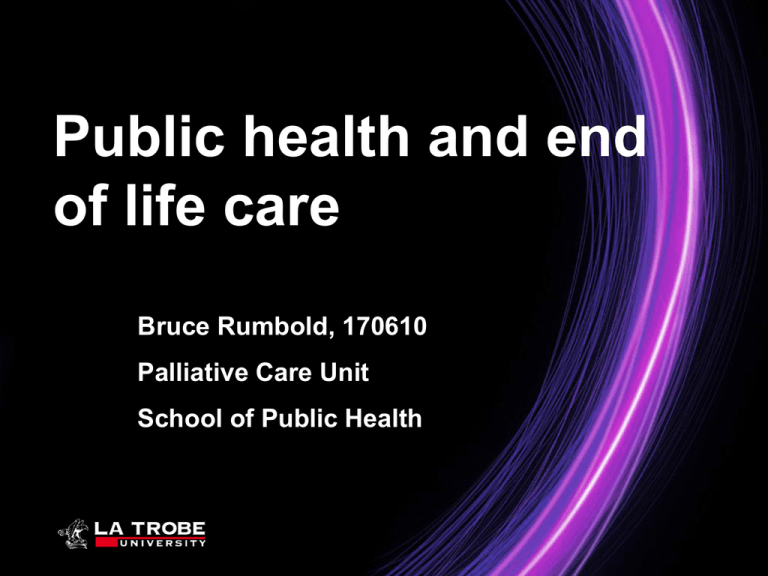
Public health and end of life care Bruce Rumbold, 170610 Palliative Care Unit School of Public Health Outline • Getting to where we now are • Signs of new directions • Ways of shaping the future? Page 2 Forms of social organisation • Traditional • Modern • Contemporary (‘post-modern’) Traditional society Traditional society Central authority is revealed (religious) knowledge Belief in powers beyond the society itself Hierarchical structures, based on custom and inheritance, reflect these higher powers Illness, suffering and death an inevitable part of the human condition; but have constructive possibilities Traditional views of health and illness Understood in moral and religious terms Personal insight invited: sick person should exercise discernment - connect present situation with a transcendent meaning Illness is both challenge and opportunity Health is salvation Illustration: Why Christians are afflicted with illness Basil the Great of Caesarea, The Long Rule 55 Some diseases are for our correction (through the pain of both the illness and its treatment) Some diseases are a punishment for sin Some diseases arise from faulty diet or any other physical origin Some illness comes at the Evil One’s request Some illness provides opportunity for exemplary suffering Some illness is to moderate sanctity • The subject that is most proper for your prayers at that time is death. Let your prayers, therefore, then be wholly upon it, reckoning upon all the dangers, uncertainties and terrors of death; let them contain everything that can affect and awaken your mind into just apprehensions of it. Let your petitions be all for right sentiments of the approach and importance of death; and beg of God, that your mind may be possessed with such a sense of its nearness, that you may have it always in your thoughts, do everything as in sight of it, and make every day a preparation for it. • And then commit yourself to sleep, as into the hands of God; as one that is to have no more opportunities of doing good; but is to awake amongst spirits that are separate from the body, and awaiting for the judgement of the last great day. • William Law (1728) "Of evening prayer" A serious call to a devout and holy life. Victorian Evangelical Version of a Good Death Jalland, P. (1996) Death in the Victorian Family. Oxford, Oxford University Press •Death takes place at home •The dying person makes explicit farewells of each family member •There is time, and physical and mental capacity, to complete temporal and spiritual business •The dying person is conscious and lucid to the end, resigned to God’s will, able to prove worthiness for salvation •Suffering is borne with fortitude, even welcomed as a test of fitness for heaven and recompense for past sins. Modern society Modern social assumptions Central authority is science, which offers (material) progress through knowledge Separation of public and private spheres of social life reflects Descartes’ separation of body and mind. Institutional structures reflect expert knowledge Knowledge is uncovered through rational, objective enquiry; is universal and quantifiable Reductionism best approach to problem-solving Modern views of health and illness Illness is a problem to be solved by experts Health is the absence of illness or disease Body is a machine Death is the worst possible outcome Sick person responsible to seek expert treatment • It is necessary to believe in immortality, insofar as it can be demonstrated that the atoms of life or the spirit of life must continue to exist after the body’s death. But of what does it consist, this characteristic of holding a body together, of causing matter to change and to develop, this spirit of life? Edvard Munch, 1892 ‘Dying Well’: a modern good death? Kastenbaum, R. (1975) 'Towards standards of care for the terminally ill, Part II: What standards exist today?' Omega, The Journal of Death and Dying, 6, 289-90. 1. The good or successful death is quiet, uneventful. Nobody is disturbed. The death slips by with as little notice as possible. 2. Not too many people are around. In other words, there is no "scene". Staff does not have to adjust to the presence of family and other visitors who have their own needs and who are in various kinds of "states". 3. Leave-taking behaviour is at a minimum. 4. The physician does not have to involve himself intimately in terminal care, especially as the end approaches. 5. The staff makes few technical errors throughout the entire terminal care process, and few mistakes in "etiquette". 6. Strong emphasis is given to the body, little to the personality or spirit of the terminally-ill person in all that is done for or to him. 7. The person dies at the right time: that is, after the full range of medical interventions has been tried, but before a lingering period sets in. 8. The staff is able to conclude that "we did everything we could for this patient". 9. The patient expresses gratitude for the excellent care received. 10. After the patient's death the family expresses gratitude for the excellent care provided. 11. Parts or components of the deceased are made available to the hospital for clinical, research or administrative purposes (via autopsy permission or organ donation). 12. A memorial (financial) gift is made to the hospital in the name of the deceased. 13. The cost of the entire terminal care process is determined to be low or moderate; money was not wasted on a person whose life could not be "saved. Dying, grief and loss as health problems • Problem-focused • Individualised • Professionalised Contemporary society Central authority is the self: individuals have right of self-determination Emerging social structures have both modern and traditional aspects Government’s role is to respect individual rights whilst managing risk Management a dominant discipline Contemporary views of health and illness Health system manages risk of illness Health and illness can be interpreted in a variety of ways: biomedicine is not the only option Occupational integration Sick person’s responsibility is to find appropriate interpretations (and act on them) Suffering arises from failure to manage risk appropriately The revival of dying Page 20 Hospice Care • • • • Physical care (palliation of symptoms) Psychological care (genuine relationship) Social care (patient-and-family as focus) Spiritual care (supporting meaningmaking, connectedness) A grass roots movement at the beginning: later adapted to the health system Health System & End of Life Care • Palliative Care • Advance Care Planning • Requested Death (PAS) Page 22 The great majority of people who are living with cancer and other life limiting or terminal diseases spend their time with families, work mates and friends, outside of any formal health care system. Many people feel unprepared when such illnesses befall them or others. In many of our local communities we need to relearn the old ways of caring for one another – those persons who are dying and those left behind (Kellehear 2005). Grief and loss: new directions (or old directions revisited?) • New rituals allowing broader participation • Mystical experiences • Afterlife explorations The great majority of people who are living with cancer and other life limiting or terminal diseases spend their time with families, work mates and friends, outside of any formal health care system. Many people feel unprepared when such illnesses befall them or others. In many of our local communities we need to relearn the old ways of caring for one another – those persons who are dying and those left behind (Kellehear 2005). • Traditional (religious) societies: – Shared social rituals • Modern (industrialised) societies: – Social silence, private coping • Contemporary (consumerist) societies: – Individual expression (and new ritual forms?) Shaping the future? • Giddens: spirituality needed to contain the utter openness of science …. • Certainly fiscal containment is not enough! Page 27 Spirituality involves relationships • • • • • With places and things (spatial) With self (intra-personal) With others (inter-personal) Among people (corporate) With transcendence • Lartey, E.(1997) In living colour: an intercultural approach to pastoral care and counselling, London, Cassell, 113. • I can only answer the question ‘What am I to do?’ if I can answer the prior question ‘Of what story or stories do I find myself a part?’ We enter human society with one or more imputed characters – roles into which we have been drafted – and we have to learn what they are in order to be able to understand how others respond to us and how our responses are apt to be construed. • MacIntyre, A. (1981) After virtue, University of Notre Dame Press, p. 216 • Under conditions of adversity, individuals often feel a pressing need to re-examine and re-fashion their personal narratives in an attempt to maintain a sense of identity. Universal, cultural and individual levels of human existence are tied together with narrative threads. Bury, M. (2001) ‘Illness narratives: fact or fiction?’ Sociology of Health and Illness 23 (3), 263-285, p. 264. • We exist in relationship with others. Throughout our lives we are hatched out from, and re-immersed in, communities that hold us, shaping our sense of who we are and who we might become. From our community at each stage we need confirmation, challenge and continuity - that is, we need to be accepted as we are, to be offered a vision of what we might become, and to be reminded of where we have been. Kegan, R. (1981) The evolving self, Harvard, Harvard University Press Revising the stories within which we live • Biographical disruption • Narrative reconstruction Models of health create horizons that structure the stories about dying, death and loss that can be told within them. • Biomedicine – health as absence of disease • Social – health as having a place in your community • Holistic – health as becoming Health Services (biomedical) Horizon within which we understand health - the health (illness) system • Goal of care is cure (health is the absence of disease) • Identity as patient • Language: diagnosis, prognostication, clinical management • Core stories: assessing, referring, diagnosing, prognosticating, treating, managing. • Key strategies: expert treatment based on diagnosis • Death an adverse event Social Horizon for understanding health - the social system • Goal of care is continuing participation (health is having a place in your community) • Identity as citizen • Language: belonging, participation, support • Core stories: networking, negotiating, allocating, prioritising, mediating, counselling • Key strategies: supporting, normalising, educating, resourcing • Death as changed participation Holistic Horizon for understanding health - expandable and inclusive Goal is healing or wholeness (health is becoming) Identity as person Language: search, meaning, companionship Core stories: healing, sustaining, guiding, reconciling, nurturing, liberating, empowering. • Key strategies: companionship in search for meaning • • • • Chronic illness narratives • Stories about the origins, onset, symptoms, effects of illness: Contingent narratives • Stories that explore and evaluate altered relationships with body, self and society: Moral narratives • Stories about changes in identity and selfpresentation: Core narratives Bury, M. (2001) ‘Illness narratives: fact or fiction?’ Sociology of Health and Illness 23 (3), 263-285. Working with narratives • Encourage individuals and communities to speak, write, illustrate, represent, enact their stories • Enquire about ‘missing’ strands: what’s being marginalised, or excluded, or is absent from this story? • Broaden horizons • Offer other stories as a prompt or guide • Support and resource communities and audiences Rediscovery of social perspectives Escalating rates of degenerative disease Re-evaluation of scientific progress Health more than the absence of disease Illness more than the presence of disease Mounting evidence for social determinants of disease Social exclusion/inclusion • The focus on capability, opportunity and choice largely reflects Amartya Sen’s thinking on freedom and human development (as in Sen, A. (1999) Development as Freedom, Oxford University Press, Oxford) Amartya Sen & capabilities • To function effectively in a modernising or modern society, people need a range of capabilities • If people lack key capabilities their life choices will be severely constrained: they will be ‘disadvantaged’ • Capability is a potential (what you could be or do if you so chose); functioning is actuality Capabilities Martha Nussbaum (2001) Economics & Philosophy 17, 67-88 • • • • • • • • • • Live a life of normal length Bodily health Bodily integrity Senses, imagination and thought Emotions Practical reason (a conception of the good) Affiliation with others Respect for other species Play Control over one’s environment (political and material) • Social justice as the distribution of ‘goods’ (capabilities or opportunities for well-being) among individuals; or social justice in terms of the relationship people have with each other, and in particular relationships between social groups? • See for example Iris Young (1990) Justice and the Politics of Difference, Princeton, Princeton University Press Determinants of successful lives McLaughlin, E. & Baker, J. (2007) ‘Equality, social justice and social welfare: a road map to the new egalitarianisms’ Social Policy and Society 6 (1), 53-68. • Respect and recognition • Resources • Love, care and solidarity • Power • Working and learning Social inclusion http://www.socialinclusion.gov.au/Pages/default.aspx • Being socially included means that people have the resources (skills and assets, including good health), opportunities and capabilities they need to: – Learn: participate in education and training – Work: participate in employment, unpaid or voluntary work including family or carer responsibilities – Engage: connect with people, use local services and participate in local, cultural, civic and recreational activities, and – Have a voice: influence decisions that affect them • Public health by its very nature is aligned with those who favour collective responsibility for the provision of good public services. • Daly, J. & Lumley, J. (2004) ‘Individual rights and social justice’ Australian and New Zealand Journal of Public Health 28 (6), 507 Public health [should join with] the voices that are arguing for a return to public policies that seek to promote civil society, encourage an investment in the social fabric of communities, and protect the environment. Baum, F. (2002) The New Public Health: an Australian perspective. Melbourne, Oxford, p. 526 Marks of a sustainable community Brown, V. & Ritchie, J. (2006) Health Promotion Journal of Australia 17 (3), 211-216. • Reflectivity • Systemic thinking • Negotiation • Equitable participation • Integration of understanding in a collective learning process

